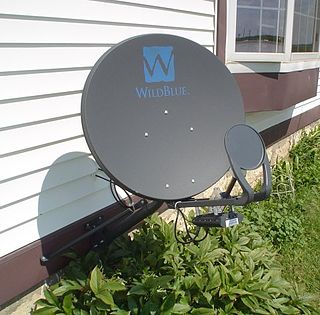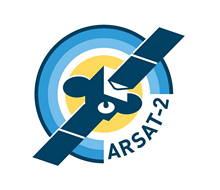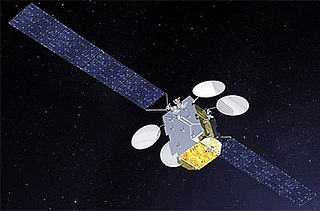
A satellite constellation is a group of artificial satellites working together as a system. Unlike a single satellite, a constellation can provide permanent global or near-global coverage, such that at any time everywhere on Earth at least one satellite is visible. Satellites are typically placed in sets of complementary orbital planes and connect to globally distributed ground stations. They may also use inter-satellite communication.
The Ka band is a portion of the microwave part of the electromagnetic spectrum defined as frequencies in the range 26.5–40 gigahertz (GHz), i.e. wavelengths from slightly over one centimeter down to 7.5 millimeters. The band is called Ka, short for "K-above" because it is the upper part of the original NATO K band, which was split into three bands because of the presence of the atmospheric water vapor resonance peak at 22.24 GHz (1.35 cm), which made the center unusable for long range transmission. The 30/20 GHz band is used in communications satellite uplinks in either the 27.5 GHz or 31 GHz bands, and in high-resolution, close-range targeting radars aboard military airplanes. Some frequencies in this radio band are used for vehicle speed detection by law enforcement. The Kepler Mission used this frequency range to downlink the scientific data collected by the space telescope.

Satellite Internet access is Internet access provided through communication satellites; if it can sustain high speeds, it is termed satellite broadband. Modern consumer grade satellite Internet service is typically provided to individual users through geostationary satellites that can offer relatively high data speeds, with newer satellites using the Ku band to achieve downstream data speeds up to 506 Mbit/s. In addition, new satellite internet constellations are being developed in low-earth orbit to enable low-latency internet access from space.

Spacebus is a satellite bus produced at the Cannes Mandelieu Space Center in France by Thales Alenia Space. Spacebuses are typically used for geostationary communications satellites, and seventy-four have been launched since development started in the 1980s. Spacebus was originally produced by Aérospatiale and later passed to Alcatel Alenia Space. In 2006, it was sold to Thales Group as Thales Alenia Space.

SES S.A., trading as SES is a Luxembourgish satellite telecommunications network provider supplying video and data connectivity worldwide to broadcasters, content and internet service providers, mobile and fixed network operators, governments and institutions.

A medium Earth orbit (MEO) is an Earth-centered orbit with an altitude above a low Earth orbit (LEO) and below a high Earth orbit (HEO) – between 2,000 and 35,786 km above sea level.

Thales Alenia Space is a joint venture between the French technology corporation Thales Group (67%) and Italian defense conglomerate Leonardo (33%). The company is headquartered in Cannes, France.
The Regional African Satellite Communication Organization (RASCOM) will provide telecommunication services, direct TV broadcast services and Internet access in rural areas of Africa. Under an agreement with RASCOM, RascomStar-QAF will implement RASCOM's first 14 communications satellite project. This joint African project is expected to lower the continent's dependency on international satellite networks such as Intelsat.
AMC-21, or GE-21, is an American communications satellite operated by SES S.A., formerly SES World Skies and SES Americom. It was launched in August 2008 and is expected to remain in service for approximately 15 years. It is currently located at 125° West longitude.
O3b Networks Ltd. was a network communications service provider building and operating a medium Earth orbit (MEO) satellite constellation primarily intended to provide voice and data communications to mobile operators and Internet service providers. O3b Networks became a wholly owned subsidiary of SES in 2016 and the operator name was subsequently dropped in favour of SES Networks, a division of SES. The satellites themselves, now part of the SES fleet, continue to use the O3b name.

O3b is a satellite constellation in Medium Earth orbit (MEO) owned and operated by SES, and designed to provide low-latency broadband connectivity to remote locations for mobile network operators and internet service providers, maritime, aviation, and government and defence. It is often referred to as O3b MEO to distinguish these satellites from SES's forthcoming O3b mPOWER constellation.
High-throughput satellite (HTS) is a communications satellite that provides more throughput than a classic FSS satellite for the same amount of allocated orbital spectrum, thus significantly reducing cost-per-bit. ViaSat-1 and EchoStar XVII do provide more than 100 Gbit/s of capacity, which is more than 100 times the capacity offered by a conventional FSS satellite. When it was launched in October 2011 ViaSat-1 had more capacity (140 Gbit/s) than all other commercial communications satellites over North America combined.

ARSAT-2 is a geostationary communications satellite operated by ARSAT and built by the Argentine company INVAP. It was launched from French Guiana alongside Sky Muster satellite using an Ariane 5ECA rocket on September 30, 2015 at 20:30hs UTC, becoming the 400th satellite to be launched by Arianespace. It is licensed to be located at 81° West longitude geostationary slot. ARSAT-2 is the second geostationary satellite built in Argentina, after ARSAT-1. Structurally and mechanically it is a copy of the ARSAT-1, the only difference being the payload and thus it has different antenna configuration.

Beyond Frontiers is the third book in a series from satellite owner and operator SES describing the past, current and future of the development of satellite broadcasting as well as the current business of the company and its strategy. The book was published in 2016, following predecessors High Above (2010) which detailed the history of the company and of satellite broadcasting, and Even Higher (2012) which looked at the future of broadcasting.
Eutelsat 8 West B is a geostationary communications satellite. Operated by Eutelsat, it provides direct-to-home (DTH) broadcasting services from geostationary orbit. The satellite is part of Eutelsat's constellation at a longitude of 8° West. Eutelsat announced the order of a new Spacebus-4000C3 satellite bus from Thales Alenia Space in October 2012.
PT Pasifik Satelit Nusantara (PSN) is a private Indonesian satellite telecommunications company.

Soyuz flight VS22 was a rocket launch conducted by multinational launch service provider Arianespace. It was the sixteenth launch of a Soyuz-ST-B launch vehicle, and the 22nd launch of a Soyuz-2 series launch vehicle from the Ensemble de Lancement Soyouz at the Guiana Space Centre. After two scheduling delays and a 33-minute logistical delay, the rocket lifted off on 4 April 2019, and successfully delivered to medium Earth orbit the final four satellites in the O3b broadband satellite constellation, which services Latin America, Africa, and Oceania. After four previous Soyuz flights delivered the constellation's first sixteen satellites, the launch increased the constellation's throughput by 26 per cent. The flight marked the second occasion in which two Soyuz-2 launch vehicles were launched on the same day, occurring hours after the launch of Progress MS-11 from the Baikonur Cosmodrome.

Eutelsat Konnect is a geostationary communications satellite operated by Eutelsat. The satellite was designed and manufactured by Thales Alenia Space on the Spacebus NEO 100 platform, and was launched on 16 January 2020 on an Ariane 5 ECA. The satellite provides broadband internet and communications coverage to Europe and Sub-Saharan Africa.
O3b mPOWER is a communications satellite system owned and operated by SES. The system uses high-throughput and low-latency satellites in a medium Earth orbit (MEO), along with ground infrastructure and intelligent software, to provide multiple terabits of global broadband connectivity for applications including cellular backhaul and international IP trunking, cruise line connectivity, disaster recovery, and military communications. The first O3b mPOWER satellites were launched in December 2022 and the system became operational in April 2024 with 6 satellites. The system's capacity will be increased by a further 7 satellites launched by 2026.










